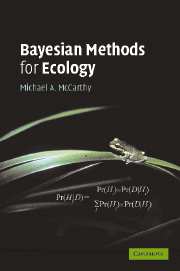Book contents
- Frontmatter
- Contents
- Preface
- 1 Introduction
- 2 Critiques of statistical methods
- 3 Analysing averages and frequencies
- 4 How good are the models?
- 5 Regression and correlation
- 6 Analysis of variance
- CASE STUDIES
- 7 Mark-recapture analysis
- 8 Effects of marking frogs
- 9 Population dynamics
- 10 Subjective priors
- 11 Conclusion
- APPENDICES
- References
- Index
7 - Mark-recapture analysis
Published online by Cambridge University Press: 05 June 2012
- Frontmatter
- Contents
- Preface
- 1 Introduction
- 2 Critiques of statistical methods
- 3 Analysing averages and frequencies
- 4 How good are the models?
- 5 Regression and correlation
- 6 Analysis of variance
- CASE STUDIES
- 7 Mark-recapture analysis
- 8 Effects of marking frogs
- 9 Population dynamics
- 10 Subjective priors
- 11 Conclusion
- APPENDICES
- References
- Index
Summary
Obtaining estimates of survival and fecundity rates is a fundamental aspect of population ecology, because these parameters, along with dispersal rates, control changes in local population sizes. The usual way of monitoring fecundity and survival rates is to identify individuals in some manner and then monitor them over time. If the individuals are easily monitored, then researchers will know when they die or breed, and it is easy to calculate the required parameters. For example, one could estimate survival rates based on the proportion of individuals that survive a given period.
It is usually difficult to monitor the survival and reproduction of individuals precisely. It may be possible to know the exact fate of many plants, but even some plants may not be apparent for several years before reappearing with above ground parts (e.g. terrestrial orchids). For animals, individuals routinely go missing, and it is difficult to be sure whether an unobserved individual is alive or dead. When estimating annual survival probabilities, we need to also estimate the probability of detecting an individual given that it is alive.
Methods
Mark-recapture methods have been developed to accommodate the chance that an undetected individual is not dead but has simply been overlooked (Lebreton et al., 1992). These methods are closely related to those used to address the issue of detectability (Chapter 5; Mackenzie et al., 2002).
- Type
- Chapter
- Information
- Bayesian Methods for Ecology , pp. 197 - 206Publisher: Cambridge University PressPrint publication year: 2007

